Papers by Niyousha Mortaza
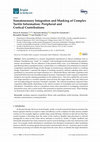
Brain Sciences
Nerve paresthesia is a sensory impairment experienced in clinical conditions such as diabetes. Pa... more Nerve paresthesia is a sensory impairment experienced in clinical conditions such as diabetes. Paresthesia may “mask” or “compete” with meaningful tactile information in the patient’s sensory environment. The two objectives of the present study were: (1) to determine if radiating paresthesia produces a peripheral mask, a central mask, or a combination; (2) to determine if a response competition experimental design reveals changes in somatosensory integration similar to a masking design. Experiment 1 assessed the degree of masking caused by induced radiating ulnar nerve paresthesia (a concurrent non-target stimulus) on a vibrotactile Morse code letter acquisition task using both behavioral and neurophysiological measures. Experiment 2 used a response competition design by moving the radiating paresthesia to the median nerve. This move shifted the concurrent non-target stimulus to a location spatially removed from the target stimuli. The task, behavioral and neurophysiological measure...
International Journal of Neuroscience
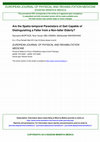
EDIZIONI MINERVA MEDICA, 2014
Fall is a common and a major cause of injuries. It is important to find elderlies who are prone t... more Fall is a common and a major cause of injuries. It is important to find elderlies who are prone to falls. The majority of serious falls occur during walking among the older adults. Analyzing the spatio-temporal parameters of walking is an easy way of assessment in the clinical setting, but is it capable of distinguishing a faller from a non-faller elderly? Through a systematic review of the literature, the objective of this systematic review was to identify and summarize the differences in the, spatio-temporal parameters of walking in elderly,falters and non-fallers and to find out if these parameters are capable of distinguishing a faller from non-faller. All original research articles which compared any special or temporal walking parameters in faller and non-faller elderlies were systematically searched within the Scopus and Embase databases., Effect size analysis was also done to standardize findings and compare the gait parameters of fallers and,non-fillerS across the selected studies. The electronic search led to 5381 articles. After title and abstract screening 30 articles were chosen; further assessment of the full texts led to 17 eligible articles for inclusion in the review It seems that temporal measurements are more sensitive to the detection of risk of fall in elderly people; The results of the 17 selected studies, showed that failers have a tendency toward a Slower walking speed and cadence, longer stride time, and double support duration. Also, fallers showed shorter stride and step length, wider step width and more variability in spatio-temporal parameters of gait. According to the effect size analysis, step length, gait speed, stride length and stance time variability were respectively more capable of differentiating faller from non-faller elderlies. However, because of the difference of methodology and number of studies which investigated each parameter, these results are prone to imprecision. Spatio-temporal analysis of level walking is not sufficient and cannot act as a reliable predictor of stalls in elderly individuals.
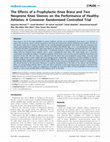
PloS one, 2012
Knee injury is one of the major problems in sports medicine, and the use of prophylactic knee bra... more Knee injury is one of the major problems in sports medicine, and the use of prophylactic knee braces is an attempt to reduce the occurrence and/or severity of injuries to the knee joint ligament(s) without inhibiting knee mobility. The aim of the present study was to examine the effect of one recently designed prophylactic knee brace and two neoprene knee sleeves upon performance of healthy athletes. Thirty-one healthy male athletes (age = 21.261.5) volunteered as participants to examine the effect of prophylactic knee brace/sleeves on performance using isokinetic and functional tests. All subjects were tested in four conditions in a random order: 1. nonbraced (control) 2. using a neoprene knee sleeve 3. using a knee sleeve with four bilateral metal supports and 4. using a prophylactic knee brace. The study design was a crossover, randomized, controlled trial. Subjects completed single leg vertical jump, cross-over hop, and the isokinetic knee flexion and extension (at 60, 180, 300u/sec). Data were collected from the above tests and analyzed for jump height, cross-over hop distance, peak torque to body weight ratio and average power, respectively. Comparisons of these variables in the four testing conditions revealed no statistically significant difference (p.0.05). The selected prophylactic brace/sleeves did not significantly inhibit athletic performance which might verify that their structure and design have caused no complication in the normal function of the knee joint. Moreover, it could be speculated that, if the brace or the sleeves had any limiting effect, our young healthy athletic subjects were well able to generate a mean peak torque large enough to overcome this possible restriction. Further studies are suggested to investigate the long term effect of these prophylactic knee brace and sleeves as well as their possible effect on the adjacent joints to the knee.
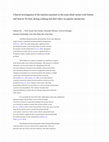
Clinical Biomechanics, 2012
Transtibial amputation patients need prosthetic devices after amputation surgery in order to rega... more Transtibial amputation patients need prosthetic devices after amputation surgery in order to regain their functional mobility and appearance (Wolf et al., 2009). The socket design plays a significant role in determining the quality of the fit and provides an interface between the prosthesis and the residual limb (Jia et al., 2004). Appropriate socket fitting in prosthetic devices can have a significant effect on the patient's comfort, mobility and level of satisfaction with their prosthesis. Skin problems are common in prosthetic users and these can appear in the formof rashes, ulcers, irritation and allergies. Their presence is commonly attributed to one of several reasons: the inadaptability of the skin, due to the intolerance of pressure by the prosthetic socket on the residual limb; bacterial proliferation as a result of a snugly-fitted socket that causes entrapment of perspiration in a closed environment; skin irritation or allergic reaction due to the materials used in the prosthetic socket and liners (Dudek et al., 2005; Dudek et al., 2006). Lower limb amputees commonly experienced residual limb skin problems with the use of the prostheses (Laing et al., 2011). Amputees often need to stop using the prosthesis entirely for a period of time as a result of the pain and discomfort caused by such skin problems. This condition can badly effect thementalwellbeing of a patient and will ultimately impact their satisfaction with a device .

BACKGROUND:
Fall is a common and a major cause of injuries. It is important to find elderlies who... more BACKGROUND:
Fall is a common and a major cause of injuries. It is important to find elderlies who are prone to falls. The majority of serious falls occur during walking among the older adults. Analyzing the spatio-temporal parameters of walking is an easy way of assessment in the clinical setting, but is it capable of distinguishing a faller from a non-faller elderly?
AIM:
The objective of this systematic review was to identify and summarize the differences in the spatio-temporal parameters of walking in elderly fallers and non-fallers and to find out if these parameters are capable of distinguishing a faller from a non-faller.
DESIGN:
Systematic review of the literature.
SETTING: NA POPULATION: NA METHODS:
All original research articles which compared any special or temporal walking parameters in faller and non-faller elderlies were systematically searched within the Scopus and Embase databases. Effect size analysis was also done to standardize findings and compare the gait parameters of fallers and non-fallers across the selected studies.
RESULTS:
The electronic search led to 5381 articles. After title and abstract screening 30 articles were chosen; further assessment of the full texts led to 17 eligible articles for inclusion in the review. It seems that temporal measurements are more sensitive to the detection of risk of fall in elderly people. The results of the 17 selected studies showed that fallers have a tendency toward a slower walking speed and cadence, longer stride time, and double support duration. Also, fallers showed shorter stride and step length, wider step width and more variability in spatio-temporal parameters of gait.
CONCLUSION:
According to the effect size analysis, step length, gait speed, stride length and stance time variability were respectively more capable of differentiating faller from non-faller elderlies. However, because of the difference of methodology and number of studies which investigated each parameter, these results are prone to imprecision.
CLINICAL REHABILITATION IMPACT:
Spatio-temporal analysis of level walking is not sufficient and cannot act as a reliable predictor of falls in elderly individuals.
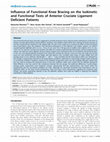
Use of functional knee braces has been suggested to provide protection and to improve kinetic per... more Use of functional knee braces has been suggested to provide protection and to improve kinetic performance of the knee in Anterior cruciate ligament(ACL)-injured patients. However, many athletes might refrain from wearing the braces because of the fear of performance hindrance in the playing field. The aim of this study was to examine the effect of three functional knee brace/sleeves upon the isokinetic and functional performance of ACL-deficient and healthy subjects. Six anterior cruciate ligament deficient (29.0±5.3 yrs., 175.2±5.4 cm, and 73.0±10.0 kg) and six healthy male subjects (27.2±3.7 yrs., 176.4±6.4 cm, and 70.3±6.9 kg) were selected. The effect of a custom-made functional knee brace, and two neoprene knee sleeves, one with four metal supports and one without support were examined via the use of isokinetic and functional tests in four sets (non-braced,wearing functional knee brace,and wearing the sleeves). Cross-over hop and single leg vertical jump test were performed and jump height, and hop distance were recorded. Peak torque to body weight ratio and average power in two isokinetic velocities(60°.s−1,180°.s−1) were recorded and the brace/sleeves effect was calculated as the changes in peak torque measured in the brace/sleeves conditions, expressed as a percentage of peak torque measured in non-braced condition. Frequency content of the isokinetic torque-time curves was also analyzed. Wilcoxon signed rank test was used to compare the measured values in four test conditions within each control and ACL-deficient group,and Mann-Whitney U test was used for the comparison between the two groups. No significant differences in peak torque, average power, torque-time curve frequency content, vertical-jump and hop measurements were found within the experimental and the non-braced conditions (p>0.05). Although the examined functional knee brace/sleeves had no significant effect on the knee muscle performance, there have been some enhancement regarding the extension peak torques and power generating capacity of the ACL-deficient subjects that could be helpful in reducing the bilateral asymmetry in these patients.
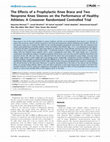
PloS one, 2012
Knee injury is one of the major problems in sports medicine, and the use of prophylactic knee bra... more Knee injury is one of the major problems in sports medicine, and the use of prophylactic knee braces is an attempt to reduce the occurrence and/or severity of injuries to the knee joint ligament(s) without inhibiting knee mobility. The aim of the present study was to examine the effect of one recently designed prophylactic knee brace and two neoprene knee sleeves upon performance of healthy athletes. Thirty-one healthy male athletes (age = 21.261.5) volunteered as participants to examine the effect of prophylactic knee brace/sleeves on performance using isokinetic and functional tests. All subjects were tested in four conditions in a random order: 1. nonbraced (control) 2. using a neoprene knee sleeve 3. using a knee sleeve with four bilateral metal supports and 4. using a prophylactic knee brace. The study design was a crossover, randomized, controlled trial. Subjects completed single leg vertical jump, cross-over hop, and the isokinetic knee flexion and extension (at 60, 180, 300u/sec). Data were collected from the above tests and analyzed for jump height, cross-over hop distance, peak torque to body weight ratio and average power, respectively. Comparisons of these variables in the four testing conditions revealed no statistically significant difference (p.0.05). The selected prophylactic brace/sleeves did not significantly inhibit athletic performance which might verify that their structure and design have caused no complication in the normal function of the knee joint. Moreover, it could be speculated that, if the brace or the sleeves had any limiting effect, our young healthy athletic subjects were well able to generate a mean peak torque large enough to overcome this possible restriction. Further studies are suggested to investigate the long term effect of these prophylactic knee brace and sleeves as well as their possible effect on the adjacent joints to the knee.
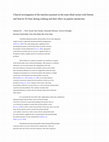
Clinical biomechanics (Bristol, Avon), 2012
Transtibial amputation patients need prosthetic devices after amputation surgery in order to rega... more Transtibial amputation patients need prosthetic devices after amputation surgery in order to regain their functional mobility and appearance (Wolf et al., 2009). The socket design plays a significant role in determining the quality of the fit and provides an interface between the prosthesis and the residual limb (Jia et al., 2004). Appropriate socket fitting in prosthetic devices can have a significant effect on the patient's comfort, mobility and level of satisfaction with their prosthesis. Skin problems are common in prosthetic users and these can appear in the formof rashes, ulcers, irritation and allergies. Their presence is commonly attributed to one of several reasons: the inadaptability of the skin, due to the intolerance of pressure by the prosthetic socket on the residual limb; bacterial proliferation as a result of a snugly-fitted socket that causes entrapment of perspiration in a closed environment; skin irritation or allergic reaction due to the materials used in the prosthetic socket and liners (Dudek et al., 2005; Dudek et al., 2006). Lower limb amputees commonly experienced residual limb skin problems with the use of the prostheses (Laing et al., 2011). Amputees often need to stop using the prosthesis entirely for a period of time as a result of the pain and discomfort caused by such skin problems. This condition can badly effect thementalwellbeing of a patient and will ultimately impact their satisfaction with a device .






Uploads
Papers by Niyousha Mortaza
Fall is a common and a major cause of injuries. It is important to find elderlies who are prone to falls. The majority of serious falls occur during walking among the older adults. Analyzing the spatio-temporal parameters of walking is an easy way of assessment in the clinical setting, but is it capable of distinguishing a faller from a non-faller elderly?
AIM:
The objective of this systematic review was to identify and summarize the differences in the spatio-temporal parameters of walking in elderly fallers and non-fallers and to find out if these parameters are capable of distinguishing a faller from a non-faller.
DESIGN:
Systematic review of the literature.
SETTING: NA POPULATION: NA METHODS:
All original research articles which compared any special or temporal walking parameters in faller and non-faller elderlies were systematically searched within the Scopus and Embase databases. Effect size analysis was also done to standardize findings and compare the gait parameters of fallers and non-fallers across the selected studies.
RESULTS:
The electronic search led to 5381 articles. After title and abstract screening 30 articles were chosen; further assessment of the full texts led to 17 eligible articles for inclusion in the review. It seems that temporal measurements are more sensitive to the detection of risk of fall in elderly people. The results of the 17 selected studies showed that fallers have a tendency toward a slower walking speed and cadence, longer stride time, and double support duration. Also, fallers showed shorter stride and step length, wider step width and more variability in spatio-temporal parameters of gait.
CONCLUSION:
According to the effect size analysis, step length, gait speed, stride length and stance time variability were respectively more capable of differentiating faller from non-faller elderlies. However, because of the difference of methodology and number of studies which investigated each parameter, these results are prone to imprecision.
CLINICAL REHABILITATION IMPACT:
Spatio-temporal analysis of level walking is not sufficient and cannot act as a reliable predictor of falls in elderly individuals.
Fall is a common and a major cause of injuries. It is important to find elderlies who are prone to falls. The majority of serious falls occur during walking among the older adults. Analyzing the spatio-temporal parameters of walking is an easy way of assessment in the clinical setting, but is it capable of distinguishing a faller from a non-faller elderly?
AIM:
The objective of this systematic review was to identify and summarize the differences in the spatio-temporal parameters of walking in elderly fallers and non-fallers and to find out if these parameters are capable of distinguishing a faller from a non-faller.
DESIGN:
Systematic review of the literature.
SETTING: NA POPULATION: NA METHODS:
All original research articles which compared any special or temporal walking parameters in faller and non-faller elderlies were systematically searched within the Scopus and Embase databases. Effect size analysis was also done to standardize findings and compare the gait parameters of fallers and non-fallers across the selected studies.
RESULTS:
The electronic search led to 5381 articles. After title and abstract screening 30 articles were chosen; further assessment of the full texts led to 17 eligible articles for inclusion in the review. It seems that temporal measurements are more sensitive to the detection of risk of fall in elderly people. The results of the 17 selected studies showed that fallers have a tendency toward a slower walking speed and cadence, longer stride time, and double support duration. Also, fallers showed shorter stride and step length, wider step width and more variability in spatio-temporal parameters of gait.
CONCLUSION:
According to the effect size analysis, step length, gait speed, stride length and stance time variability were respectively more capable of differentiating faller from non-faller elderlies. However, because of the difference of methodology and number of studies which investigated each parameter, these results are prone to imprecision.
CLINICAL REHABILITATION IMPACT:
Spatio-temporal analysis of level walking is not sufficient and cannot act as a reliable predictor of falls in elderly individuals.